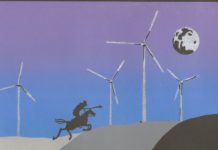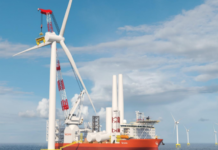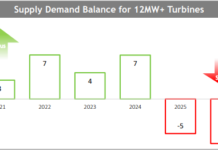Market-oriented policy analysts have not been shy about cataloguing the problems surrounding windpower development. But in the enthusiasm to oppose the government interventions accompanying wind generation, market-based analysts sometimes have strayed beyond principled defense of markets and unwittingly offered support to anti-market NIMBYism and other meddlesome sentiments. Policy analysts examining wind power issues should consider more carefully which issues ought to be pursued through the policy process.
Two Images
Wind power has two images. In one view, wind power is glamorous, hi-tech, future oriented and almost sexy. Advertisements for products from automobiles to watches to banking services casually feature tall, slowly spinning wind turbines in the background, hoping to suggest that the advertised product, too, is glamorous, hi-tech, and future oriented, and maybe a bit sexy.
A second view shows wind power in a much less favorable light: the product of misguided environmentalism twisted into government-funded corporate welfare. No hi-tech glamour in this view. Instead, destruction and waste becomes emblematic of a windpower industry, which has blighted farm and ranch lands with industrial towers and power lines, killed bats and birds, raised the cost of electricity, and squandered tax dollars.
The second view dominates among policy analysts with a libertarian or conservative policy bent. Market-oriented policy shops have produced several critiques of wind power: the Cato Institute, Heritage Foundation, Competitive Enterprise Institute, Reason magazine, the Heartland Institute. Each has issued policy papers or published editorials or articles about wind power. The details vary, but the overwhelming verdict is negative: wind is more costly than conventional power even with subsidies, it wastes land, the turbines are ugly, the power output is unreliable and requires fossil-fuel backup generation, it produces the most power when it is least needed, the spinning blades are dangerous to both wildlife and human health, and construction damages the local environment.
In addition, wind power development often requires substantial investment in electric transmission lines, which consumes more land and adds to the expense. The Texas Public Policy Foundation has produced a fairly comprehensive critique of wind power development that touches on all of these points and a few more (see links below).
Business versus Policy Issues
The first view contributes to a few policy problems the hi-tech glamour of wind power gains it unearned public support and therefore special political favor. As one wind energy association analyst has said, windpower “polls extremely well” and has support of both Republicans and Democrats.
But the second, negative view also contributes to policy problems when the analysis goes beyond issues of appropriate public policy and gets involved in a seemingly indiscriminate piling on of negatives. Renewable power policy in the United States has involved the government in heavy-handed subsidies, which is wasting taxpayer monies, distorting investment into electric generation and raising consumer costs. But these points represent about the limit of the market-based objections to windpower development. Most of the technology and resource-use concerns listed above are, for the most part, nobody’s business but the business owners. When analysts encourage negative attention to decisions that naturally fall within a business’s scope of actions, they end up encouraging further unconstrained expansion of public policy.
Let’s sort through that catalogue of complaints about windpower one at a time:
Wind power is more costly than conventional power generation. This claim is not always true, but probably true in many cases and for most of the time. But so what? It may cost more to make a Ferrari than it costs to make a Subaru, but so long as the consumer is free to choose which price it wishes to pay, no real policy issue emerges. Sure, many states mandate that consumers purchase a certain amount of renewable power, but the objection here is to the government picking winners in the marketplace. The mandate would be just as objectionable in principle if renewables were cheaper than conventional generation, so let’s leave cost out of it.
Wind power development often requires substantial investment in electric transmission lines. Wind power development can require investment in electric transmission lines to get the power from the wind farm to the frequently-distant major power consuming regions. (Of course this is not too different for other forms of power generation, only in those cases the fuel frequently moves by pipeline or railroad before being converted to power.) Transmission remains a government-regulated business, even in regions and states with restructured markets, which makes it a public policy concern.
For years the rules governing transmission investment were intimately tied to the needs of the monopoly electric utility. As independent power generation became important to the industry, the rules governing transmission investment had to change too. Accommodations for renewable power are of a similar nature. If policies in fact unduly favor renewable generators, then market-based policy analysts may have a complaint. But development of the transmission grid can be useful in reducing the generator market power that is a legacy of years of government-protected monopolies. It is at least possible that most of the value of transmission investment to support renewable power will come from the encouragement of competition and the resulting more efficient operation of the grid. Consumers should favor such transmission development.
Windpower development is land-intensive. This claim is true in some respects, but greatly exaggerated. It is certainly the case that windpower projects blanket thousands and thousands of acres, but such production is consistent with many other uses of the land – excepting a rather small footprint for the turbine itself and associated facilities. And, again, so what? Agriculture also uses a lot of land, but that is no reason to oppose farming. Landowners are generally considered capable of deciding how much, if any, land they wish to devote to various opportunities. Public policy involvement in these private decisions should be limited, not encouraged.
Wind power output is unreliable. Three parties should be concerned with the variability of windpower output: the company selling the wind power, the company buying the wind power, and the transmission network operator providing responsible for reliable operation of the power grid.
Other power market participants using the grid have a secondary interest, but this interest should be limited to ensuring each power transaction pays an appropriate share of the costs of operating a reliable transmission grid. There are important and difficult issues here, but for the most part they are technical grid operation and market design issues only passingly related to public policy. The various regional power markets are working out the issues, and progress will probably be faster if Congress doesn’t get too interested. Market-oriented policy analysts ought not to encourage politicians to think wind power variability is a public policy issue that politicians need to address.
Wind power requires fossil-fuel backup generation. In a point related to the variability of wind, it is sometimes claimed that each new megawatt of wind power capacity requires the support of a new megawatt of fossil-fuel generation. There is, maybe, a grain of truth here, but as stated the point is greatly exaggerated. First, to an extent every generation unit supplying the grid has to be supported by backup generation in the case that the unit under produces or fails altogether. Reliable grid operation
requires the presence of units kept in reserve. But not every single unit supplying the market is matched by a unit kept in reserve – since independently operated generators are unlikely to fail at the same time, the system just needs a few units in reserve at any one time. For this reason, most regional transmission grids have already had sufficient reserve capacity available to accommodate the level of wind power that has been added.Wind power presents some new challenges – unexpected output variations across wind farms in the same area will be correlated rather than independent. But this is a technical issue to be handled by the parties involved, and the main technical issue is assigning wind power developers an appropriate share of the costs of the necessary reserves.
Wind power produces the most power when the power is least needed. On average this claim is true for most existing installed wind power capacity. For example, in West Texas, where the boom in windpower investment is most pronounced, wind speed and wind power output is higher during Spring and Fall than it is in Summer, but the demand for electricity is highest during the Summer. In addition, windpower output tends to be higher overnight, while demand tends to be highest on late summer afternoons. (On the other hand, coastal and off-shore wind power developments tend to produce more power during the day and less power at night.)
An issue related to these last two items concerns references to wind power’s capacity factor. A generator’s capacity factor is calculated by dividing the unit’s power output over a period of time by the amount of power that would have been generated by the unit operating at maximum output. It is frequently noted that wind power generators will have capacity factors that range between 20 and 40 percent, while coal, natural gas, and nuclear power plants tend to have capacity factors that range from 70 up to 95 percent. But capacity factors have substantially different meanings for wind power and the other forms of generation. And once again, the policy significance is limited. If the “capacity factor” of a Subaru plant is higher (or lower) than that of a Ferrari plant, then … so what?
Wind turbines are dangerous to both wildlife and human health. Obviously coming into contact with fast-spinning blades can be dangerous – to humans as well as to birds and bats. Turbines sometimes fail in dramatic and hazardous fashion, as easily findable YouTube videos will show. But producing and burning coal is probably more hazardous to humans, birds and bats as well, and even natural gas is not without risks to animals. Any balanced analysis would at least seek to put the risks of wind power in appropriate context.
It also seems somewhat disingenuous when a think tank usually given to complaining that the endangered species act or similar policies interfere with private property rights starts holding up injured birds in the attempt to discourage private rights to develop property, simply because government subsidies are involved.
Windpower construction damages the local environment. If wind power development is damaging your property, first try negotiation with the developer and if that doesn’t work, then existing property law provides various opportunities for you to pursue a remedy. To the extent that wind power development is damaging other people’s property, they should pursue their rights. It usually is not a public policy concern.
Wind power turbines are ugly. Of course, no policy analysis calls turbines ugly as a serious policy argument; the name-calling just tries to detract a bit from wind power’s glamorous image. But making the claim in the context of a policy argument tends to align the analyst with a NIMBY crowd. If the development of someone’s property is going to spoil a historic view or other community value, the market-based approach would be for members of the community to negotiate purchase of an easement.
My main point is that much of the litany of negative factors surrounding wind power is of limited relevance to a policy analysis grounded in a political philosophy of limited government. Yes, the government intervention into the economy in support of favored kinds of power production is objectionable. But it is just the intervention that is the problem, not the way that the businesses and property of other persons are being developed.
Of course it isn’t just wind power that benefits from intervention, other resources and technologies also see various government supports. It turns out that tallying up subsidies for different resources gets surprisingly complicated, but it is clear that renewable power is the recipient of substantial government support at the moment, particularly on a per-MWh generated basis. Defenders of wind power would also point out that it produces no direct air emissions when producing power, and therefore should be encouraged relative to fossil-fueled generators that do emit pollution. The claim has some validity, but as I have suggested elsewhere, the current set of subsidies for wind is a very inefficient way of pursing those policy goals.
A Suggestion to the Free-Market Community
Now that I have made my main point, let me suggest a principled way to violate it and bring some of these factors back into policy analysis. As any market-oriented person who engages in policy debates has realized, not everyone shares their viewpoint on the role of markets and the value of limited government. In such cases an appeal to principles will not be persuasive. Winning policy arguments appeal to more pragmatic considerations. Cost-benefit analysis is the standard approach.
A serious cost-benefit analysis of public policies supporting wind power would have reason to examine the costs of windpower and the value of its output. For such an analysis, some, but not all, of the negative factors surrounding wind become relevant. Even here a market-based analysts should exercise care to keep issues that should be primarily matters of private choice out of the policy discussion, lest politicians and other less-discriminating analysts become encouraged to further intervene in the market.
For the most part, these market-oriented policy papers and essays are not pursuing a balanced assessment of costs and benefits, just trying to make a case against windpower interventions. I support making a principled case against intervention; I urge policy analysts to refrain from arguments which miss the mark and thus may inadvertently give support to interventionists.
Michael Giberson is an instructor and research associate at the Center for Energy Commerce at Texas Tech University’s Rawls College of Business, blogs on energy economics (including wind power) and other topics at Knowledge Problem. This article was first published on Master Resource.
Appendix: Market Think Tank Critiques of Windpower
Most of these are fairly short commentaries; Drew Thornley’s study for the Texas Public Policy Foundation is probably the most thorough).
Cato Institute: Jerry Taylor, “Picken’s Plan to Rig the Market,” 2008; Robert L. Bradley, Jr., “Eco-dilemmas of Renewable Energy,” 1997.
Competitive Enterprise Institute: Steven J. Milloy, “The Wind Cries ‘Bailout’,” 2008; Neil Hrab, Baptists, Bootleggers and Wind Po
wer, 2004.Heartland Institute: Cheryl K. Chumley, “Questions Plague Efforts to Grow Wind Power Use,” 2008.
Heritage Foundation: Ernest Istook, “Hot air about wind power,” 2008.
Reason magazine: Ron Bailey, “Wind Breaks,” 2002.
Texas Public Policy Foundation: Drew Thornley, “Texas Wind Energy: Past, Present, and Future,” 2008.









It is so important to note that fossil fuels have themselves benefited from government support of their monopoly for years. They are themselves a highly subsidized business. I love the way you put in focus how disingenuous some of the environmental criticisms are.